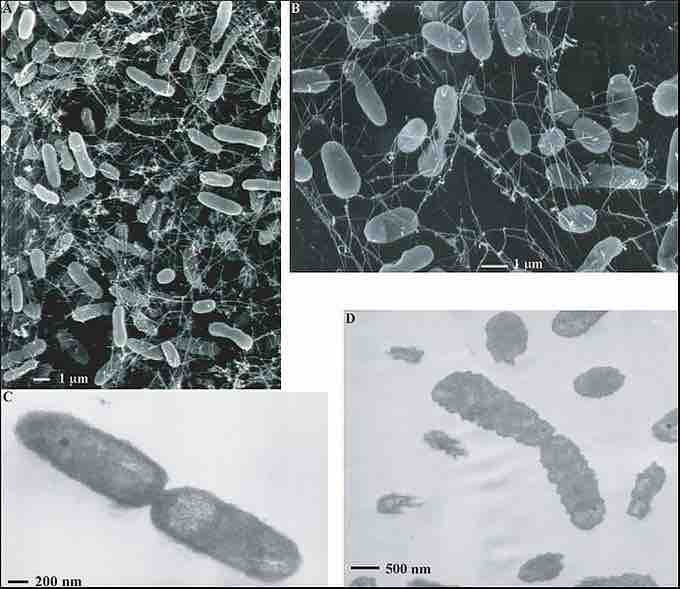Along with Thermotogae, members of Aquificae are thermophilic eubacteria (thermophiles) .

Thermophile bacteria isolated from deep-sea vent fluids.
This organism eats sulfur and hydrogen and fixes its own carbon from carbon dioxide. (A,B) scanning electron micrographs, and (C,D) transmission electron micrographs in thin sections.
Aquificales
The Aquificae phylum is a diverse collection of bacteria that live in harsh environmental settings. They have been found in hot springs, sulfur pools, and thermal ocean vents. Members of the genus Aquifex, for example, are productive in water between 85 to 95 °C. They are the dominant members of most terrestrial neutral to alkaline hot springs above 60 degrees Celsius. They are autotrophs, and are the primary carbon fixers in these environments. They are true bacteria (domain bacteria) as opposed to the other inhabitants of extreme environments, the Archaea.
Comparative genomic studies have identified six conserved signature indels (CSIs) that are specific for the species from the phylum Aquificae and provide potential molecular markers for this phylum. Additionally, a 51 amino acid insertion has been identified in SecA preprotein translocase which is shared by various members of the phylum Aquificae as well as two Thermotoga species. The presence of the insertion in the Thermotoga species may be due to a horizontal gene transfer. In the 16S rRNA gene trees, the Aquificae species branch in the proximity of the phylum Thermotogae (another phylum comprising hyperthermophiles) close to the archaeal-bacterial branch point. However, a close relationship of the Aquificae to Thermotogae and the deep branching of Aquificae is not supported by phylogenetic studies based upon other gene/protein sequences and also by conserved signature indels in several highly conserved universal proteins.
Thermotogae
The phylum Thermotogae is composed of gram-negative staining, anaerobic, mostly thermophilic, and hyperthermophilic bacteria. The name of this phylum is derived from the existence of many of these organisms at high temperatures along with the characteristic sheath structure, or "toga," surrounding the cells of these species . Recently, some Thermotogae existing in mesophilic temperatures have also been identified. Although Thermotogae species exhibit Gram-negative staining, they are bounded by a single unit lipid membrane. Therefore, they are monoderm bacteria. Because of the ability of some Thermotogae species to thrive at high temperatures, they are considered attractive targets for use in industrial processes. The metabolic ability of Thermotogae to utilize different complex-carbohydrates for production of hydrogen gas led to these species being cited as a possible biotechnological source for production of energy alternative to fossil fuels.

Thermotoga sketch
Outline of a Thermotoga maritima section showing the "toga. "
This phylum presently consists of a single class (Thermotogae), order (Thermotogales), and family (Thermotogaceae). It contains a total of nine genera (viz. Thermotoga, Petrotoga, Thermosipho, Fervidobacterium, Marinitoga, Kosmotoga, Geotoga, Thermopallium, and Thermococcoides), all of which are currently part of the family Thermotogaceae. In the 16S rRNA trees the Thermotogae have been observed to branch with the Aquificae in close proximity to the archaeal-bacterial branch point. The Thermotogae have also been scrutinized for their supposedly profuse lateral gene transfer (LGT) with Archaeal organisms. However, recent studies based on more robust methodologies suggest that incidence of LGT between Thermotogae and other groups including Archaea is not as high as suggested in earlier studies.
Until recently, no biochemical or molecular markers were known that could distinguish the species from the phylum Thermotogae from all other bacteria. However, a recent comparative genomic study has identified large numbers of conserved signature indels (CSIs) in important proteins that are specific for either all Thermotogae species or a number of its sub-groups. The newly discovered molecular markers provide novel means for identification and circumscription of species from the Thermotogae phylum in molecular terms and for future revisions to the taxonomy of this phylum.